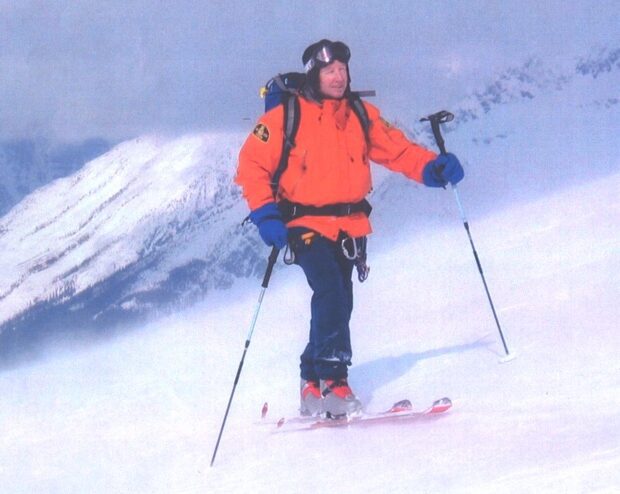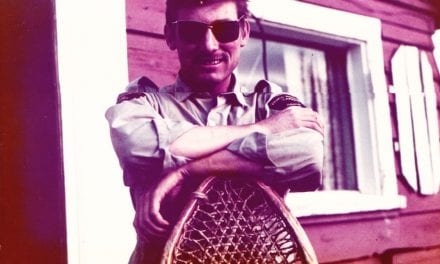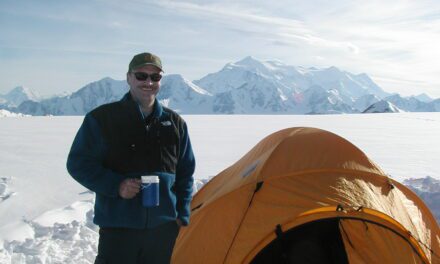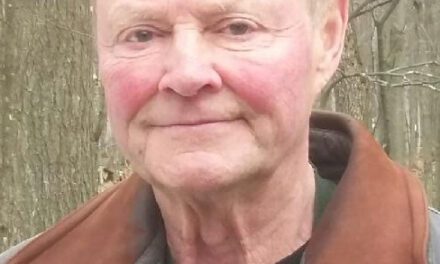When I started I believed like many that wilderness was the ultimate form of protection for the parks. But through our work in fire management, we developed a longer term view of how parks had evolved and where things were headed. preservation or ecological integrity became the model that we were working from. That required a lot more studies in archaeology, fire history and the impact First Nations had on the landscape. it made managing the park, resource conservation, much more complicated but much more interesting.
SH: Good answer. Are there any legends or stories associated with the Warden Service that you can share? Is there anyone from the Service that stands out in your mind?
Ian: I guess Bob Haney would be the first person that I met that had a vision of what resource management should be. Back in the early 70s he was working towards re-introducing prescribed fire and re-introducing bison to Jasper. He was well ahead of the rest of Parks Canada in doing that. Some of the other visionary people I thought were Charlie Zinkan, Jillian Roulet, Stephen Woodley, and Peter Achuff. They had a large influence on Parks Canada, particularly in the larger mountain parks
SH: Is there anything about the Warden Service, as you knew it, that you would want future generations to know?
Ian: One of the things the Banff managers very much believed was that after you had a year or so in town being mentored on various things, that you should go to the backcountry for three or four years. Knowing the backcountry – vegetation, topography, wind patterns – certainly helped me choose areas suitable for prescribed fire, as did some of microclimatology course in university and ski area avalanche control. Paragliding also helped understand wind and topography. However, I had a few too many close calls paragliding so I gave that up once we had kids. I would say an intimate knowledge of the land base is a good thing for any one involved in resource management or public safety.
SH: Do you have any lasting memories as a Warden? Favorite park, cabin, horse, trail, humourous stories,
Ian’s Ghost of Windy Cabin story:
In mid November 1982 I made a solo horse patrol to stock the district cabins with food for the winter. The river crossings on the lower Panther had frozen up so I ended up staying at Windy for a few days. When I had been at Windy Cabin a couple weeks earlier the wood furnace was working fine and it was easy to keep the house warm. But now for some reason, the furnace would not draw and the cabin was cold and full of smoke. No one had been in the cabin since I was last there and I couldn’t figure out what the problem was. I kept piling on the kindling and looking for a damper on the furnace or chimney but there wasn’t any. Late on the second day I was in the basement again trying to get the furnace working. I had the oven mitts on my hand and I just touch the pipe from the furnace to the chimney and it fell off in my hands. Suddenly, the furnace just roared to life and a stream of fire and embers was pouring out of the furnace up in the floor joists above. I frantically tried to get the stove pipe back on but no way it would fit. As long as I held it close to the furnace and the chimney the fire and embers were contained, but something was wrong here. Suddenly I looked at the pipe and realized it was symmetrical so I swapped it end for end and it slide on beautifully and the furnace burned cleanly without any further problems. I have often thought that if the pipe had fallen off the furnace during the night I would have woken up a crispy critter. And I still don’t know why the furnace didn’t draw properly since it was an open pipe no matter which end you looked in. Perhaps the Windy Cabin ghost was playing tricks on me.
SH: Do you want to tell some horse stories? You’ve got some great stories. Do you want to talk about losing horses?
Ian: You have to understand the context of losing horses. It was one of those embarrassing things but it happened to everyone, particularly in areas where you didn’t really have horse feed flown in or fenced pasture. The code word on the radio was “I’ll be working around the cabin today” which often translated to “I have to spend the day hunting for my horses”. That was part of the culture of being independent. You would really do anything before you would admit that you’d lost your horses.

Horse stories submitted by Ian.
The Warden with no hat comes back – 1995
“I’d like to stop at the jewelry store and pick up my wrist-watch” I said to Brian Low as we were driving down Banff avenue. “It got it wet last month when I was crossing the Alexandra River,” I explained. “Oh” said Brian, “were you wearing it at the time?” “I was,” I admitted, and I then told Brian the story of how that came to happen.
I was working in the Fire and Vegetation position and looking at places that needed to be burned with prescribed fire. The Alexandra Valley seemed to fit the bill, it was far from the crowded Bow Valley, a southwest aspect covered with an old pine forest. But first it required a site visit by a Parks Canada archeaologist Gwynn Langemann and Don Mickle, the Cultural Resources warden. We left the parking lot at Sunset Pass and rode directly up the river flats for about 5 kilometers before joining the trail. A few hours later, we reached a spot where the trail crossed the river. Don rode in the muddy water and he and his horse immediately plunged into a deep hole with water well over the saddle, the horse managed to wheel around and lunged back to the bank. Don studied the river for a moment and then took another tentative approach a few metres downstream. Slowly they crossed, the water reaching no more than the stirrups. Gwynn and I rode in leading the 2 pack horses, carefully following his watery path.
Eventually we arrived at the Alexandra cabin, a tiny decrepit hut that barely had room for 2 people. The next day Don and Gwynn rode further up the valley to Watchtower Lake, while I headed back to the trailhead and town for some reason. I had Badger my saddle horse and Banjo a reliable pack horse. Upon reaching the river crossing I rode confidently into the stream. Suddenly, Badger stepped into a deep hole and was swept off his feet. His four hooves pointed upstream, Badger was on his side, me in the saddle with a leg underneath him. I pushed off the saddle horn to get out of the saddle, this allowed him to get his feet under him again. As he scrambled to get back to the riverbank I grabbed at a saddle string but it slipped through my gloved hand. I rolled onto my stomach and began swimming hard but I was sinking fast, as I was wearing a large oil-skin slicker, heavy leather chaps and riding boots. Soon I gave up swimming and tried to stand up – to my surprise I was back in knee-deep water. I waded back to the bank where Badger was standing, Banjo the packhorse was loose, and had wisely decided to remain on the upstream bank. I stripped of the slicker, chaps and boots and tied them behind my saddle.
While I was doing this, Banjo, became impatient and entered the river on his own accord. Unfortunately, he picked an angle that carried him too far downstream, and he ended up against a small cliff on the far side of the river. He turned upstream and began swimming hard to get to the proper crossing. His nearly empty pack boxes acted like water-wings keeping him afloat. As I watched in horror he slowly worked his way upstream to a spot where he clambered out onto the far bank. He stood there looking back at us to see how we would make out. With my packhorse across the river and ready to head for home I had no choice but to make another attempt at the crossing. I stepped up on my horse and rode back into the river. This time I nailed the crossing and was soon on the far shore. No damage done except that during my swim I had lost my Stetson down the river. I put on my boots, chaps and slicker and caught Banjo.
I was about to head down the trail when David Simpson, the son of famous mountain man Jimmy Simpson Jr., and an experienced guide and horseman himself rode up with a guest and a few horses. I had to make a decision fast. Should I tell him about the problems I had at the crossing? The Simpson family had a long history with the park and held most park staff in very low esteem. Here I was a young warden with no Stetson, on my first ride up the valley, – who was I to tell David Simpson how to cross the river? He had probably ridden up the valley fifty times. I decided to say nothing and after a short greeting I headed down the trail. Later, I heard that he rode into the river right where Don had his dunking, managed to struggle back to the near bank and then spent 2 hours cutting a new trail that avoided the river crossing altogether. He apparently couldn’t understand how I had managed to get across so easily. I don’t know if anyone ever told him the real story about my swim in the Alexandra.
A Trip to Limestone Lake – c 2007
One fall the Banff Park planner Mike Murtha and a BC Parks planner made plans to see Joffre Creek and Limestone Lake that lie south of Banff in the Height of the Rockies. The Chief of Resource Conservation, Ian Syme, Mike Murtha and I would start from the Mt. Shark trail head and ride to the Palliser cabin, then over Palliser Pass and down the Palliser River to Joffre Creek where we would meet the BC planner and his guide and outfitter John Niddrie. The trip started out well, but on the second day, it rained heavily for the entire afternoon and we arrived at Joffre Creek drenched to the bone. The small nylon tents we brought to sleep in seemed none to inviting but there was a 4 horse stock trailer parked nearby so we scraped out the horse manure with our boots, and moved in with our pack boxes. Although some rain was blowing in through the open sides, it was the best we could do. Within a few minutes, Ian Syme had pulled out a bottle and some cups. “The bar is open”, he announced. Later we spread out our pack tarps and slept in the trailer. There had been a huge windstorm that put down a lot of timber so the five of us hiked up the Joffre Creek trail with a chainsaw, bucking the deadfall and evaluating the terrain for horses. There were some recent land-slumps along the creek that made riding the trail impossible, but there was a helicopter on fire duty in Banff so I called that in and we flew to Limestone Lake. After an hour or two of hiking around, we hiked back to our Campsite on the Palliser River, packed up and rode upstream to an outfitters cabin where we spent the night.
That evening over our second or third glass of scotch, I said to Ian, “What is the worst horse wreck you have had in your career?” We spent an hour or two regaling Mike with various misadventures, but neither of us had had a serious problem involving an injured horse or rider. The next day we headed back to Banff Park over Palliser Pass. Near the summit of the pass was a short but very steep section of trail on a side hill. Ian, at the front of the line got off and prepared to lead his horse as did I, riding at the back. Mike, riding a tall horse called Cleo (?), stayed on his horse as he was reluctant to dismount on the offside (uphill) and it was it was impossible to get off on the left side of the horse because of the steep side hill.
I didn’t see exactly what happed next because there was a packhorse between Mike and I, but I heard a commotion and Ian shouting something. I worked my way past the packhorse and Mike’s horse lying on its side, hooves pointed uphill and Mike still in the saddle with his left leg trapped under the horse. Mike was white as a ghost, and I suspected that he must have a broken leg or pelvis. The horse had one front leg hooked around a tree and was not moving either.
I went to work on the off-side cinches and as able to undo them. It seemed impossible that the horse could roll up hill, it looked like the only way to get Mike from under the horse, was to have the horse roll over top of Mike. Ian went back to his get his saddle axe. Then, I grabbed the saddle horn and gave it a jerk. Feeling the saddle loosen, the horse, made an unbelievable effort, rolling up hill and managed to stand up. Not expecting so little resistance, I ended staggering backward with the saddle in my arms. I quickly set the saddle down and untied the halter shank from the saddle.
Slowly, Mike began to test his limbs and joints and after a few minutes got to his feet. There wasn’t much room on the side hill but I re-saddled Mike’s horse and then we led our saddle horses and pack horses over the last 50 metres of trail to the pass. I then traded horses with Mike and we rode for a couple hours to the Palliser patrol cabin. By this time some color had returned to Mikes face and he insisted he was fine. Despite Mikes protests, we called a helicopter and he flew to Banff and went to the emergency department to get checked out. Nothing serious, was the diagnosis, he was cleared to go back to work the next day.
However, the next morning it was all Mike could do to climb two flights of stairs to his office in the administration building. Hmmm, maybe he better get a second opinion about his health. This time the X-rays showed he had a hemothorax – a blood-filled lung from a broken rib. It definitely took the prize for the worst horse wreck that Ian and I had ever been in but fortunately was not nearly as bad as it could have been.
SH: Do you want to talk about being able to travel with the kids in the backcountry?
Ian: That was one of the cool things that was left over from the district warden days, because district wardens would take their wives out and sometimes their kids. It was an accepted part of district warden life, and you could do that without question. Access to backcountry cabins allowed us to get the kids to remote places at a very early age. There were lots of weekend ski, hiking and riding trips. The two longer trips that stand out in my mind are the circuit we did down the Spray, Bryant and Brewster Creek when Jack was about 10, and the hike through Chilkoot Pass in the Yukon.
SH: Ya, those were great trips.
SH: Well Tim LaBoucane told some good fire stories about you, so come on, tell at least one good fire story. I remember a fire that you and Tim LaBoucane lit at Snow Creek summit, only to discover there wasn’t a burn plan for any such fire.
Ian: I was given the task of writing a burn plan in the morning and this was early in DOTS (Computer) technology, and I could grind out about 15 words a minute, but I wrote a burn plan in the morning and in the afternoon I wrote the environmental assessment and they had to be on Dave Day’s (Superintendent’s) desk at four in the afternoon to get signed. So that was one of my most memorable prescribed fires I guess.
SH: I do recall that one. I was also thinking about the time I gave birth to our daughter Leah and you were out lighting a fire that afternoon.
Ian: Ya, I thought I had time to squeeze that in, and wasn’t really doing much in the hospital anyways. There was always an unhealthy level of dedication to the job in the Warden Service, and it was particularly bad in the fire program. One day Rob Oshiovy was getting married at 2 pm and we had to chase him out of the office at noon. Brian Low was always working on his phone or computer on weekends and at night. Cliff White will work til noon on the day of his funeral I’m sure. People were somewhat obsessed with their jobs. After I retired I realized I was wound pretty tight. It took a couple of years to unwind get a little better perspective on life.
SH: Do you ever miss being a Warden? (Tape 40:52)
In the decade since I retired I have stayed involved in the Warden Service and staff through volunteer work on various projects – wolverine research, fire effects studies and backcountry travel for various reasons. To be able to do this, I had to attend Parks Canada courses to recertify in avalanche rescue, first aid and horsemanship. The second time I was at the Ya Ha Tinda on a horsemanship course in retirement (2013) I told Rick Smith, I need some paperwork to prove that I have been here. Rick and Jean framed a certificate awarding me “Rookie of the Year Achievement Award”. I also had a couple years on the Banff/CP Rail Grizzly Bear project, so I had a slow transition period from work to retirement. I continue to travel the backcountry by hiking and skiing and returned to some older hobbies – canoe and raft trips. I wouldn’t go back to work no matter how much they paid me. The road behind me is a lot longer than the road ahead, I don’t want to waste it working.
SH: What year did you retire? What do you enjoy doing in retirement?
I retired in 2010. I have done a dozen or more week-long canoe and raft trips, mostly in Utah and Oregon. . I’ve been able to ski and backpack with my kids including Berg Lake, and Shadow Lake and a climbed a few peaks like Temple and Cascade. I’ve been back to Cairn Pass which was one of my favourite places in Jasper. I’ve been lucky to stay healthy and continue to enjoy the outdoor life.
SH: Is there anything I haven’t asked you that you think I should know about the Warden Service?
Ian: If there was ever a motto that described the Warden Service I think it would say “Anything worth doing, is worth doing to excess”. I think the toughest job in the outfit is the Chief Warden/Res. Con Manager who has to manage and channel this excess of energy, and ambition into a common, reasonable, useful direction.
SH: Is there anyone else I should talk to?
Ian: If you want the history of the fire program, I think Mark Heathcott would be the person to talk to. He’s a historian and a meticulous note taker and likes to spin a yarn, so I would defer to Mark on that.
SH: Do you have any photos of yourself as a Warden that you would like to donate to the Project, or that we may copy? Do you have any artifacts/memorabilia that you would like to donate to the Project (Whyte Museum)
SH: Oh, I forgot this question. What made the Warden Service such a unique organization? (Part 2: Tape 7:05)

Ski touring in the Asulkan Valley – Glacier National Park
Ian: It was always a very close-knit organization. From 1909 to 1968 they took the greenest guys and put them in the most remote district and told them to survive. That was a bonding experience for sure. Then the job became broader because of the public safety program and eventually a lot of other things were added to the mix. It was an interesting coffee room to have lunch in because there was such a diverse collection of people, but at various times in the past we had all worked together and had some common roots or history. It has changed a lot in the past 30 years, but from what I can see, the staff are still very proud of what they do, the uniform they wear and committed to the future of national parks.
End/sh
This interview was conducted by Susan Hairsine.
Susan Hairsine worked for over 30 years for Parks Canada in Resource Conservation and Operations in Mt. Revelstoke/Glacier, Jasper and Banff national parks. She also worked for Public Safety in Western and Northern Region. She was also the Executive Assistant to the Chief Park Wardens of Jasper and Banff national parks. During her career she obtained funding for an oral history of Parks Canada’s avalanche personnel. Her experience working with several of the interviewees during her and their careers has been an asset to the oral history project.



